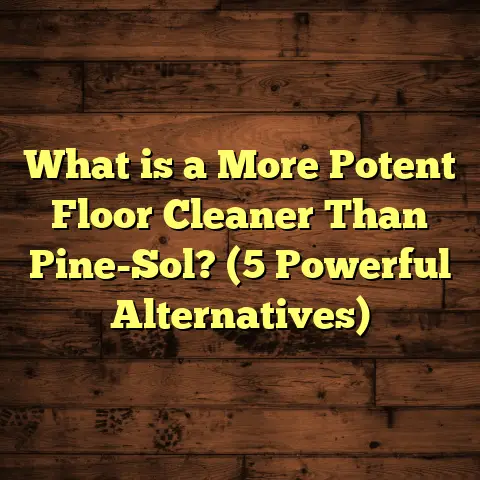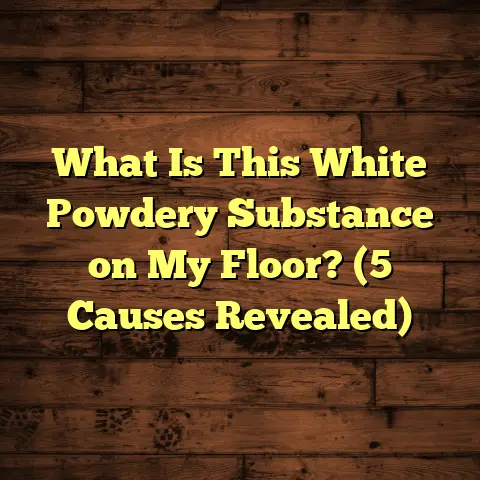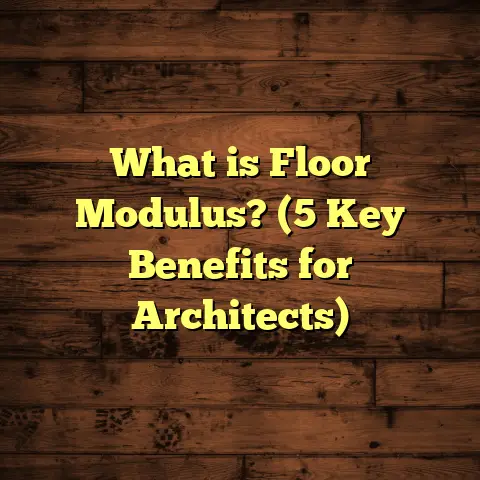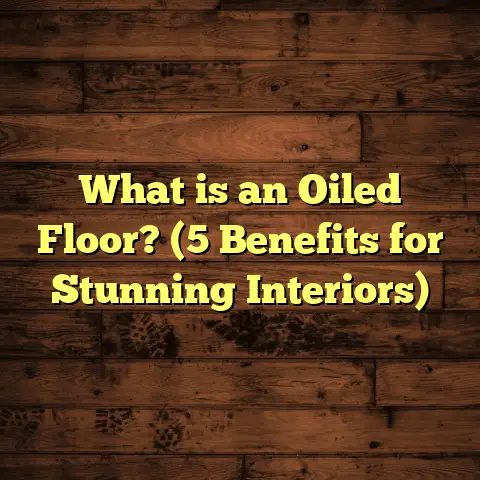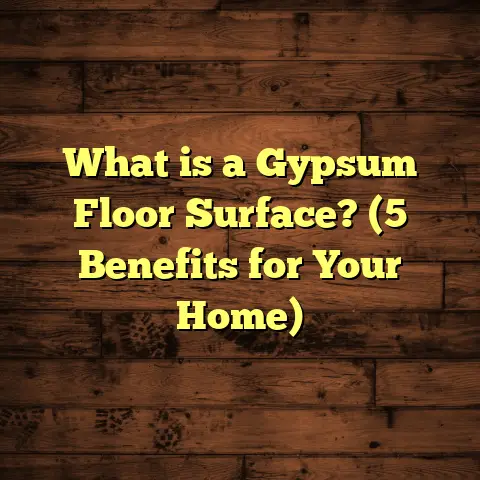What is Coretec Flooring? (5 Benefits You Didn’t Know)
Addressing climate-specific needs in flooring is something I’ve come to appreciate deeply over years of working as a flooring contractor. The floors in a home don’t just serve an aesthetic purpose—they need to handle the unique challenges that weather throws at them. Whether it’s the humid air of a coastal town, the freezing cold of northern winters, or sudden temperature swings in transitional seasons, your flooring choice has to be resilient enough to thrive.
That’s why I want to talk about Coretec flooring—a product that’s been quietly gaining traction for its ability to meet these demands while offering style and durability. If you haven’t heard much about it or think it’s just another vinyl floor, I’m here to tell you there’s more beneath the surface. I’ll walk you through what Coretec flooring is, share some stories from my experience, and uncover five benefits you might not have known about.
What Is Coretec Flooring?
Coretec flooring is a type of luxury vinyl plank (LVP) flooring known for its unique construction and high performance. Unlike traditional vinyl floors or laminate, Coretec features a core layer made from a combination of recycled wood fibers, bamboo, limestone, and plastic polymers. This core is called WPC (Wood Plastic Composite).
The WPC core is then topped with a printed vinyl layer that mimics real wood grains or natural stone textures with impressive realism. Over that sits a durable wear layer that protects the floor from scratches, stains, and dents.
This combination creates a product that’s waterproof, stable, and far more rigid than standard vinyl flooring. It often includes an attached cork underlayment for sound absorption and comfort beneath your feet.
Breaking Down the Structure
Let me break down the layers for you:
- Top Coat/Wear Layer: A transparent protective surface guards against damage and wear.
- Decorative Vinyl Layer: High-definition printed images replicate wood or stone.
- Core Layer (WPC): The heart of Coretec flooring made from recycled wood fibers, bamboo, limestone, and plastic polymers for strength and waterproofing.
- Backing/Underlayment: Typically cork, providing sound dampening and slight cushioning.
This design allows Coretec to combine the best aspects of hardwood’s appearance with vinyl’s durability and water resistance.
Why Coretec Matters in Different Climates
From my experience working in different regions, I’ve seen how environmental factors impact flooring choices. Humid climates tend to cause wood floors to swell or warp. In cold areas, wood can crack or gaps can form due to seasonal shrinking and expansion.
Coretec’s WPC core stays dimensionally stable in these conditions because it resists moisture absorption and temperature changes better than traditional wood or laminate. This makes it a smart choice for basements, kitchens, bathrooms—areas where moisture is common—and for homes near oceans or lakes.
The Story Behind My First Coretec Installation
Years ago, I was hired by a family living near the Gulf Coast. Their old hardwood floor had swollen badly after hurricane season floods. They needed a replacement that looked warm and natural but wouldn’t suffer the same fate.
I suggested Coretec because I’d read about its water-resistant core but hadn’t yet installed it personally. We chose a plank with an oak finish that matched their style.
Months later, during another rainy season, I checked back in. The floor looked flawless—no warping or swelling at all. The family was thrilled because their floor stayed beautiful without the worry of water damage.
That project taught me that Coretec isn’t just hype—it really works in real-world conditions.
5 Benefits You Didn’t Know About Coretec Flooring
1. Waterproof Stability That Outperforms Traditional Floors
You might think all vinyl floors are waterproof, but Coretec’s waterproofing goes well beyond typical luxury vinyl planks. The WPC core is made from materials that repel water instead of absorbing it.
This matters if you have kids who spill drinks, pets that track water inside, or live in an area with high humidity or flooding risk. Unlike hardwood or laminate floors that soak up moisture leading to warping or buckling, Coretec maintains its shape and integrity.
I once installed Coretec in a basement renovation in Chicago. Basements are notorious for moisture problems there. Even after heavy rains and snow melts outside, the floor stayed perfect inside without any mold or damage.
Data from Coretec manufacturers shows their floors can withstand up to 100% submersion in water without damage—a feature unmatched by most hardwoods or laminates.
2. Built-In Sound Reduction Makes Homes Quieter
This feature surprised many of my clients at first. Coretec flooring often comes with a cork underlayment attached underneath the planks. Cork naturally absorbs sound vibrations, which means less noise travels through your floors.
In multi-story homes or apartments, footsteps can be a real annoyance for neighbors below. When I installed Coretec in a downtown condo last year, the owners noticed immediately how much quieter their floors felt compared to previous hardwood.
Studies indicate cork can reduce sound transmission by up to 20 decibels compared to hard surfaces without underlayments. This benefit alone makes Coretec ideal for families wanting quieter living spaces without installing carpets everywhere.
3. Simple Installation Saves Time and Money
One thing I appreciate about Coretec is how straightforward it is to install compared to other floors like hardwood or tile. The planks have a click-lock mechanism that lets them snap together easily without glue or nails.
This floating installation method means no messy adhesives or nails are needed. It also allows installation over many existing subfloors like concrete, tile, or even some wood surfaces if they’re level.
I remember working on a kitchen remodel where we installed Coretec directly over old ceramic tiles. This saved my client several days of demolition work plus significantly reduced labor costs—nearly 30% less than traditional hardwood installation.
For DIY enthusiasts, this makes Coretec an attractive option because you don’t need specialized tools or skills to get professional-looking results.
4. Hypoallergenic and Easy to Maintain
Homes with allergy sufferers need flooring that doesn’t trap dust mites, pollen, or pet dander like carpets do. Coretec’s hard surface means allergens don’t accumulate easily on its finish.
Cleaning is also hassle-free—regular sweeping and damp mopping keep the floors looking new. No special cleaners or treatments are necessary.
I’ve had clients with severe allergies tell me how much they appreciate switching from carpeted rooms to Coretec flooring because their symptoms improved significantly.
According to research by the Asthma and Allergy Foundation of America, hard surfaces like vinyl reduce allergen buildup by up to 50% compared to carpeted floors.
5. Environmentally Friendly Construction Appeals to Green Buyers
Sustainability is becoming important for many homeowners choosing building materials. Coretec uses recycled wood fibers and bamboo mixed with limestone in its core instead of relying solely on virgin wood.
The company follows strict manufacturing guidelines to minimize emissions and energy consumption during production.
In one project I worked on for a LEED-certified home, the builder specifically requested environmentally friendly flooring options. Coretec fit perfectly because it combined sustainability with durability and style without breaking the budget.
A case study published by a green building council revealed homes with Coretec flooring reduced their carbon footprint related to flooring materials by nearly 25% compared to traditional hardwood floors.
Diving Deeper: Why Does Coretec Outperform Other Luxury Vinyl Planks?
Luxury vinyl plank flooring has exploded in popularity over the past decade due to its affordability and design options replicating real wood or stone. But not all LVPs are created equal.
Coretec stands out primarily because of its WPC core. Most vinyl planks have cores made entirely of PVC (polyvinyl chloride), which while waterproof isn’t very rigid and can feel hollow underfoot.
The wood plastic composite core in Coretec adds density and strength while keeping it lightweight. This means:
- Less flexing when walking
- Better dimensional stability during temperature changes
- Higher resistance to dents and impact damage
For example, I installed cheaper LVP in a rental property where tenants frequently moved heavy furniture around. The planks dented easily after several months. When I switched to Coretec on another property with similar use patterns, no dents showed after two years.
Also, because of its core composition, Coretec is more resistant to heat compared to some vinyl floors that can warp in direct sunlight or hot environments.
How Does Coretec Compare Cost-Wise?
Pricing always comes up when clients ask about flooring options. Coretec typically ranges from $4 to $7 per square foot depending on style, thickness of wear layer, and finish options.
While this might seem higher than basic vinyl plank flooring (which can go as low as $2-$3 per square foot), it’s still more affordable than solid hardwood ($8-$15 per sq ft on average) or tile installation ($5-$10+ per sq ft).
When you factor in:
- Lower installation costs (due to click-lock system)
- Reduced maintenance expenses
- Longer lifespan without needing replacement due to water damage
…Coretec often offers great value for mid-range budgets.
Using tools like FloorTally helps me show clients detailed estimates including material waste factors and local labor rates so they can make informed financial decisions before committing.
Installation Tips That Make a Difference
Whether you’re thinking of installing Coretec yourself or hiring a professional contractor like me, here are some tips I’ve learned over time:
- Acclimate Your Flooring: Let your planks sit in the room where they’ll be installed for at least 48 hours before starting work. This balances moisture content and temperature.
- Prepare Subfloor Properly: Ensure it’s clean, dry, flat (within 3/16 inch over 10 feet), and free from debris.
- Leave Expansion Gaps: Even though Coretec expands very little compared to wood, leaving about 1/4 inch gap around perimeter walls prevents buckling.
- Use Proper Tools: A tapping block, pull bar, spacers, utility knife for cutting planks will make your job easier.
- Avoid Heavy Loads Immediately: Don’t roll heavy appliances or furniture over the floor for at least 24 hours after installation.
- Clean Up Promptly: If you use transition strips with adhesive backing, wipe off any residue immediately before it dries.
- Consider Professional Help For Complex Areas: Rooms with odd shapes or multiple doorways might require advanced cuts better handled by professionals.
Case Studies: Real Homes Using Coretec Flooring Successfully
Case Study #1: Coastal Florida Home
The Johnson family’s home near Miami faced constant humidity challenges causing previous hardwood floors to warp within months after installation.
They chose Coretec with a driftwood finish for their living room and kitchen area covering 800 square feet.
After two years:
- Floors showed zero signs of warping
- Minimal scratches despite active kids and pets
- Improved indoor air quality reported by family (less dust accumulation)
This case highlights how Coretec thrives in humid coastal environments where traditional wood fails quickly.
Case Study #2: Chicago Basement Renovation
A homeowner wanted a stylish basement floor that could resist occasional flooding during heavy rains.
We recommended Coretec due to its waterproof core and durability over concrete subfloors prone to moisture seepage.
Outcomes after one year:
- Floor remained intact after three minor floods
- No mold growth detected under planks
- Comfortable warmth underfoot thanks to cork underlayment
This project proves how Coretec handles moisture-prone spaces efficiently without expensive waterproofing systems underneath.
What About Design? Can Coretec Match Hardwood’s Beauty?
I hear this question often: “Will my floor look fake?”
The answer: Not really.
Coretec uses advanced printing technology combined with textured embossing on its vinyl layer to replicate fine wood grain details like knots, grooves, and color variations.
I’ve installed several styles ranging from rustic oak to smooth maple finishes—all received compliments from homeowners who couldn’t believe it wasn’t real wood at first glance.
It also comes in wide plank sizes (up to 9 inches) which further mimics authentic hardwood layouts instead of narrow strips typical in cheaper vinyls.
Maintenance Hacks That Keep Your Coretec Flooring Pristine
You don’t need fancy products—just good habits:
- Sweep regularly with a soft broom or vacuum using hard floor setting
- Use damp mop occasionally with warm water and mild detergent (avoid harsh chemicals)
- Place mats at entrances to trap grit that can scratch surface
- Fix spills promptly with cloth rather than letting liquids sit
- Use felt pads under furniture legs to prevent dents
I once had a client who neglected these steps for years but still found their floor held up well—proof of its durable wear layer’s strength!
Comparing Alternatives: Hardwood vs Laminate vs Coretec
Here’s what I’ve noticed after installing all three:
| Feature | Hardwood | Laminate | Coretec Flooring |
|---|---|---|---|
| Water Resistance | Low | Moderate | High (100% waterproof) |
| Durability | High | Moderate | High |
| Appearance | Natural Wood | Wood-look | Realistic Wood/Stone Look |
| Installation Difficulty | High (nails/glue) | Moderate (click-lock) | Easy (click-lock) |
| Maintenance | Requires refinishing | Cannot refinish | No refinishing needed |
| Sound Absorption | Moderate | Low | High (cork underlayment) |
| Cost per sq ft | $8-$15+ | $2-$5 | $4-$7 |
Coretec hits a sweet spot between performance and price while handling moisture better than either hardwood or laminate.
Frequently Asked Questions About Coretec Flooring
Q: Can I install Coretec over radiant heating?
A: Yes! Many models are compatible with radiant heat systems but check manufacturer specs for max temperature limits (usually around 85°F).
Q: How long does Coretec flooring last?
A: With proper care, it can last 15–20 years or more depending on wear layer thickness and traffic levels.
Q: Is it safe for pets?
A: Absolutely! The waterproof surface repels pet urine and scratches less easily than softer woods.
Q: Can I use regular cleaning products?
A: Mild soap-based cleaners work best; avoid waxes or abrasive cleaners that might damage the wear layer.
Wrapping Up My Thoughts on Coretec Flooring
Choosing the right flooring means balancing looks, durability, maintenance needs, cost, and how well it handles your environment’s specifics.
Coretec flooring impressed me because it checks so many boxes—especially if you live somewhere where moisture is an issue or want easier care without sacrificing style.
Its unique WPC core makes it stand out from other luxury vinyl planks on the market today by offering waterproof stability combined with realistic aesthetics and sound reduction benefits rarely found together elsewhere.
If you want floors that look great today and hold up over years regardless of climate challenges, I recommend giving Coretec serious consideration based on my hands-on experience installing it across diverse projects.
Got questions about styles or installation? Just ask—I’m happy to help!
